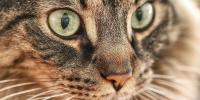Have you ever wondered what the world looks like to your cat? What kind of colors do they see and how can their eyes adjust to the dark so easily compared to our own? This is something that has mystified cat owners and scientists alike. Debates about whether cats can see color or if their eyesight is monochrome has stirred the imaginations of experts in our times. The question of how a cat’s eyesight works has been studied repeatedly with new findings creating new inquiries. So, what exactly do we know about a cat’s vision? It turns out, we have learned quite a lot from studying these fascinating furballs.
Cat Eye Anatomy
A cat’s eye anatomy is a unique and incredible science to study. At first, it seems close to the anatomy of human eyes, but when you take a closer look, you see that they have some extra layers which we do not. Here is a general overview on their eye anatomy:
- Cornea. The cornea is the clear dome on the outer surface of the eyeball. It helps to protect the eye, it allows light to enter, and it helps to focus the light onto the retina located at the back of the eye. This is like our human eye anatomy.
- Iris. This is the part of the eye that contributes to those beautiful eye colors we see in our cat, which makes each kitty unique. This part of the eye helps to control the amount of light that enters by constricting or expanding the pupil.
- Pupil. Just like for us, the pupil is the black part of the eye located in the center of the iris. If the lighting becomes dim, the pupil expands to allow more light in. If the lighting is bright, the pupil gets smaller to restrict the amount of light coming in. This is often when you see a cat’s pupil turn into thin slits.
- Lens. This is the area of a cat’s eye located right behind the iris. The lens can change shape to focus the light on the retina.
- Retina. This is the part of the cat’s eye that controls what cats can see. It is in the back of the eye and is where the light entering through the pupil is meant to go. The retina contains two types of photoreceptors (rods and cones), which convert the light into the visual images that cats see via electrical signals to the brain. Cats have six-to-eight times more rod cells than humans. This allows them to have a better peripheral and stronger sight in dim lighting strengthening their night vision. The cones allow cats to see better during the day and are responsible for their color perception.
- Tapetum lucidum. This is one of those features which is unique to a cat and assists them in seeing in low-light conditions. It is also why a cat’s eyes glow at night. The tapetum lucidum is a reflective membrane stationed right behind the retina. If some light does not reach the retina, the reflective membrane acts as a mirror and bounces that light back towards the retina giving the rods a second chance to absorb the light and improve a cat’s vision in dim lighting.
- Nictitating membrane. This is another unique physical attribute that is unique to cats. It is a third eyelid that helps to protect the cat’s eyes from potential trauma, such as when they are prowling through blades of grass to capture their prey. This thin membrane can partially close when a cat is sick and can often be seen when they are sleepy.
It’s incredible to see how similar and different a cat’s eye anatomy is compared to humans.
Cat Vision vs. Human Vision
As you saw above, there are many comparative features between cat and human eye anatomies, which also affect the way we see the world. Right now, you might be wondering, Exactly how unique is a cat’s vision vs. a human’s vision?
Turns out, there are quite a few contrasts one can make between cats and humans:
- Humans are 10-12 times better at detecting motion during the daytime than cats are. This is due to the higher amount of cone cells that we have in comparison to our feline counterparts, allowing us to see more vivid colors than our cats.
- Cats have 6-8 times more rod cells and only need one-sixth of the amount of light that humans do. This allows them to see much better in dim lighting and at night. Experts theorize that the reason for this is because cats are crepuscular mammals that are most active at dawn and dusk when the light is low. Having this ability allows them to see and hunt their prey easier in dim conditions.
- Cats can see a range of about 200-degrees compared to our 180-degree views, which gives them a wider field of view. Their greater peripheral vision allows them to spot prey better while hunting.
- Cats have vertical pupils compared to our round ones. There are many reasons for this. For starters, when a cat’s pupil turns into slits, it restricts the amount of light entering the eye, protecting the retina from any potential light damage during the day. This also helps cats to improve their depth perception when they are out hunting.
- Cats have larger corneas than we do, which allows more light to enter their eyes.
- A cat’s lens is closer to the retina, creating brighter images especially at night.
- Cats have a tapetum lucidum, which increases their sensitivity to low light situations. They also have a nictitating membrane, which is a third eyelid that protects their eyes from trauma. These are unique features in a cat which humans don’t have.
In other words, while humans can see better during the day and more vivid colors, cats can see brighter images at night and have a wider field of range than we do.
What Do Cats See?
Usually, kittens gradually open their eyes within the first 8-12 days of their life and do not have the best vision at first. Initially, they are nearsighted, but as they grow older their vision develops. Within a few months, they have adult vision and can see much better.
Color Vision
Cats see very similar to someone who is colorblind. They are not able to pick up on shades of pinks and reds as easily as greens and blues. For example, purple might come off as a different shade of blue to cats. They are also unable to see the same richness of hues and saturation that we can. Therefore, many colors are not as vivid and can appear dull to them compared to humans.
Visual Acuity
The average human has a visual acuity of 20/20 vision, whereas a cat can range from 20/100 to 20/200 vision. In other words, cats must be about 20 feet away to sharply see what an average human sees about 100-200 feet away. Of course, visual acuity is one of those areas where ongoing studies are still occurring. Currently, the norm in the scientific community is that cats have a visual acuity of 20/100 to 20/200 vision allowing them to see even the smallest movement or well-hidden shape.
Visual Field
Cats have a wider visual field than we do and can see at 200 degrees, compared to our 180 degrees. The visual field refers to the area seen when the eye focuses on a single point. This includes all areas above, below, and to the sides. Since a cat’s eyes face forward like ours, cats can pinpoint the distance between themselves and their prey, ensuring accuracy and success in their hunting endeavors.
Night Vision
While cats struggle seeing fine details and rich colors, they can see brighter images in the dark and low lighting. This is thanks to the increased number of rods that they have, allowing them to need only one-sixth of the amount of light that humans do. They can see about 5.5-7 times better than humans can in dim light.
Are Cats Nearsighted or Farsighted?
There are three types of main descriptions that get referred to regarding image focusing that are related to the retina:
- Nearsightedness (myopia). When faraway objects look blurry due to the image focusing in front of the retina
- Farsightedness (hyperopia). When close objects appear blurry due to the image focusing behind the retina
- Emmetropia. When the image focuses as it is meant to
Most scientists would say that cats typically have normal eyesight, however, this is another one of those areas that is debated and has new studies which foster new findings. Some scientists say that cats don’t have the muscles to change their eye lens shape, requiring them to be further away to see these objects clearly in comparison to humans. This view means a cat is prone to being farsighted. At the same time, other scientists say that since cats need to be about 20 feet away to see something as sharply as a human who can see these same objects clearly at 100-200 feet away, this makes them more prone to being nearsighted. Numerous scientists take the middle road and say that most cats are emmetropic, with some of them being slightly nearsighted and some of them being slightly farsighted. Scientists also agree that different breeds might be more prone to changes in eyesight. It really depends on who you ask, and it is clear that more research is needed in this area.
How to Check a Cat’s Vision
It’s so important for pet parents to keep a lookout for changes in their loved one’s eyes for any serious conditions. Symptoms of eye problems and eye infections in cats might include:
- Swollen eyelids
- Redness
- Changes in color
- Cloudy eyes
- Watery cat eyes
- Squinting
- Sensitivity to light
- Clumsiness and bumping into things
- Rubbing or scratching at their eyes
- Visible nictitating membrane (third eyelid) more than usual
- Unequal pupils
- Eye discharge
- Etc.
In severe cases, there might also be changes in your cat’s appetite and activity levels. They may even spend time in unusual places. If you notice any of the symptoms above or unusual behaviors from your cat, it’s best to reach out to your vet right away.
When you bring your kitty to the veterinarian, there are a few ways they might test your kitty’s vision:
- They might observe how your cat is moving around the exam room or how they follow an object when it is tossed
- They might try to check whether your cat blinks when a hand is moving towards their peripheral vision (without touching their face or eyes)
- They might test the retina’s light reflexes by shining a light into the cat’s eyes
- They might use a tonometer, a special instrument that tests the eye pressure
Whichever way they check your cat’s vision, your vet will be able to tell you if there is any cause of concern or if your kitty has normal eyesight…well, for a cat!
For more expert tips on cat behaviors, explore our other understanding cats articles.
Related articles

Earn myPurina Rewards with Every Purchase
Use your points for treats, toys, and gift cards with myPurina app.




